Free E-Mail
Bible Studies
Beginning the Journey (for new Christians). en Español
Old Testament
Abraham
Jacob
Moses
Joshua
Gideon
David, Life of
Elijah
Psalms
Solomon
Songs of Ascent (Ps 120-135)
Isaiah
Advent/Messianic Scriptures
Daniel
Rebuild & Renew: Post-Exilic Books
Gospels
Christmas Incarnation
(Mt, Lk)
Sermon on the Mount
(Mt 5-7)
Mark
Luke's
Gospel
John's Gospel
7 Last Words of Christ
Parables
Jesus and the Kingdom
Resurrection
Apostle Peter
Acts
The Early Church
(Acts 1-12)
Apostle Paul
(Acts 12-28)
Paul's Epistles
Christ Powered Life (Rom 5-8)
1 Corinthians
2 Corinthians
Galatians
Ephesians
Vision for Church
(Eph)
Philippians
Colossians,
Philemon
1
& 2 Thessalonians
1 & 2 Timothy,
Titus
General Epistles
Hebrews
James
1 Peter
2 Peter, Jude
1, 2, and 3 John
Revelation
Revelation
Conquering Lamb of Revelation
Topical
Glorious Kingdom, The
Grace
Great Prayers
Holy Spirit, Disciple's Guide
Humility
Lamb of God
Listening for God's Voice
Lord's Supper
Names of God
Names of Jesus
Christian Art
About Us
Podcasts
Contact Us
Dr. Wilson's Books
Donations
Watercolors
Sitemap
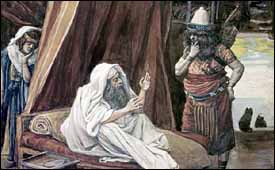 James J. Tissot, "Isaac Sends Esau to Hunt"(c. 1896-1902), gouache on board, Jewish Museum, New York. |
Jacob's Life in a Nutshell
You can't adequately sum up Jacob's career in just a few paragraphs, but for the sake of perspective, here's an attempt:
Jacob is the grandson of Abraham, to whom God revealed himself, and the son of Isaac. He is born a twin and spends his life in sibling rivalry with his (slightly) older brother Esau.
He has two streaks that are to dominate his life: a sly, deceptive nature and a quest for spiritual things. As his spiritual side grows, his deceptive side diminishes.
Because his deceptive behavior incurs Esau's anger, Jacob flees for his life to Haran, the family's ancestral home in Mesopotamia. There he acquires two wives, two concubines, and a dozen children. When he arrives in Haran, he has only the clothes on his back to call his own. He leaves 20 years later a wealthy man, which he attributes to God's blessing.
As he returns to Canaan, he wrestles with God, reconciles with Esau, and settles again in the Promised Land, living at Succoth, Shechem, Bethel, Hebron, and finally Goshen in Egypt. His sons are jealous of Jacob's favorite son Joseph, whom they sell into slavery. But Joseph eventually rises to second in command of all Egypt.
When Jacob is an old man, a famine devastates Canaan, forcing the family to buy grain in Egypt. Through a course of events, Joseph reconciles with his brothers and moves the entire clan to Egypt, where Jacob dies at age 147.
There it is in a nutshell, but we'll spend seven weeks examining the lessons and significance of his life.
Yahweh and the Religions of the Ancient Near East
Jacob grows up with the monotheistic faith of his father and grandfather, but the family in Mesopotamia are idolaters and polytheists, worshippers of many gods (Joshua 24:2).
|
|
Jacob's wife Rachel, who grows up in Mesopotamia, steals her father's "household gods" (31:32-35; 35:2-4). Her family's names -- Terah, Laban, Sarah, and Milcah -- contain linguistic elements that reveal allegiance to the moon-god,1 who is referred to in several inscriptions as "Sin/Shahar, the Lord of Haran."2 He was the tutelary god of Haran.
Worship of the moon god involved temples as well as ziggurats with small temples on the top. These temples were staffed by priests (who offered sacrifices and made libations), singers and musicians, as well as male and female prostitutes (whose activities many scholars relate to the fertility cult).3 Much later than Jacob, the Israelites are warned against worship of the moon, sun, and stars (Deuteronomy 4:19; 17:2-5), though this kind of worship continued under idolatrous kings (2 Kings 23:5-12).
The Patriarchs' Religion
Jacob, however, is a monotheist, a worshipper of one God. He uses primarily three words for God.
-
El is the generic Canaanite name for the cosmic deity.
-
Yahweh is God's revealed name. It is sometimes translated "Jehovah" in the KJV, but usually it is expressed as "LORD" in English Bibles, following the Jewish tradition of not pronouncing the divine name, but substituting Adonai, "Lord," instead.4
-
El Shaddai ("Almighty God") is used occasionally by Isaac and Jacob (28:3; 35:11; 43:14; 48:3; 49:25).
The monotheism of the patriarchs contrasts sharply with the polytheism of their forebears (Joshua 24:2). The patriarchs believe God to be the Lord of the cosmos (14:22; 24:3), supreme judge of mankind (15:14;18:25), controller of nature (18:14; 19:24; 20:17), highly exalted (14:22) and eternal (21:33).5
Their relationship with God is personal rather than formal. However, Jacob and the other patriarchs practiced various forms of worship, including building altars, erecting stones, offering sacrifices and libations, calling on the name of Yahweh, circumcision, prayer, making vows, and tithing. We'll examine some of these further as we study the details of Jacob's life.
Authorship of Genesis and the Pentateuch
Though the traditional view is that Moses was the author of the Pentateuch, since the Enlightenment there has been growing speculation about authorship. The most celebrated and complex theory of authorship was advanced by German Old Testament scholar Julius Wellhausen (1844-1918), referred to as "the Documentary Hypothesis." He theorized four sources which are abbreviated JEDP:
J Yahwistic
E Eloistic
D Deuteronomic
P Priestly
The Yahwistic strand could be identified, so goes the theory, by the editor's use of Yahweh (Jehovah) or LORD for God; the Eloistic strand by the use of El for God. Wellhausen was widely influential and the theory grew more and more complex -- and speculative. These days, however, Wellhausen's JEDP theory is in disarray. R.N. Whybray commented in 1995 on the state of Pentateuchal studies:
"There is at the present moment no consensus whatever about when, why, how, and through whom the Pentateuch reached its present form, and opinions about the dates of composition of its various parts differ by more than five hundred years."6
Certainly Jesus, the Jews, and the early church all believed that the Pentateuch (which the Jews referred to as "the law") was inspired by God and attributed it as a whole to Moses. It is likely that the materials Moses and other early editors worked with represent oral and written traditions dated much earlier than themselves. Whether Moses was the first to write down the stories of Abraham and his descendents, or served as an editor himself, we just don't know.7
Our focus will not be on speculative theories of sources, but on the Book of Genesis that comes down to us in the Bible and the meaning of that revelation.
Dating of Jacob
When did Jacob live? Dating is complex. It is difficult to find fixed events in Genesis that can be connected absolutely to dates established from archaeology.
One approach to dating the patriarchs is to backtrack from the first fixed event we find in the Bible -- a statement that Solomon laid the temple foundation in the 480th year after the exodus (1 Kings 6:1), which would date the exodus at about 1447-1446 BC. The so-called "early dating." Working backward from the genealogies and other data in the Pentateuch puts the birth of Abraham in 2166 BC.8
Another approach to dating uses a combination of history and archaeology. There are no archaeological findings that refer specifically to Abraham, Isaac, and Jacob, so where they fit into the archaeological periods is not precise.9
Chronology of Jacob
An early date for the Exodus would put the birth of Jacob and Esau at about 2006 BC,10 while a late date for the Exodus puts the birth year around 1835 BC.11 As I've studied the issues, the early date for the Exodus makes more sense to me. The following dates are based on an early date for the Exodus.12
| Date | Event | Genesis Ref. |
|
2006 BC |
Birth of Jacob and Esau, probably in Beer-lahai-roi |
25:26 |
|
1966 |
Marriage of Esau in Beersheba, age 40 |
26:34 |
|
1930 |
Jacob's journey to Haran, age 76 |
28:2 |
|
1923 |
Jacob's marriages, age 83, Haran |
29:23, 28 |
|
1918 |
Birth of Judah, Jacob's age 88 |
29:35 |
|
1916 |
End of Jacob's 14 year labor for his wives, Jacob's age 90 |
29:30 |
|
1916 |
Birth of Joseph |
30:23 |
|
1910 |
End of Jacob's stay with Laban, age 96 |
31:41 |
|
1910 |
Jacob's arrival at Shechem |
33:18 |
|
1902 |
Rape of Dinah |
34:1-2 |
|
1900 |
Marriage of Judah, Judah is 18, Jacob is 106 |
38:1-2 |
|
1899 |
Selling of Joseph, Joseph is 17 |
37:2, 27 |
|
1888 |
Joseph imprisoned |
39:20; cf. 41:1 |
|
1886 |
Joseph released from prison, made ruler of Egypt |
41:1, 46 |
|
1886 |
Death of Isaac, Isaac is 180, Jacob is 120 |
35:28 |
|
1879 |
Beginning of famine, Jacob is 127 |
41:54 |
|
1878 |
Brothers' first visit to Egypt |
42:1-2 |
|
1877 |
Brothers' second visit to Egypt |
43:1; 45:6, 11 |
|
1876 |
Jacob's descent to Egypt at age 130 |
46:6; cf. 47:9 |
|
1859 |
Death of Jacob at age 147 |
47:28 |
|
1806 |
Death of Joseph at age 110 |
50:22 |
Chief Places Jacob Lived
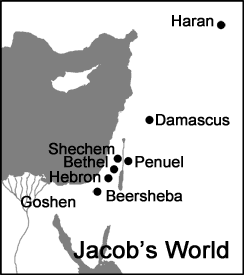 As a semi-nomadic shepherd, Jacob moved frequently,
especially in his earlier years. Here are some of the places he lived.
As a semi-nomadic shepherd, Jacob moved frequently,
especially in his earlier years. Here are some of the places he lived.
Beer-lahai-roi
Beer-lahai-roi, Jacob's birthplace (25:11) means, "well of the Living One who sees me" (Genesis 16:7). It is the site of a well in the Negev desert south of Beersheba, on the road to Shur, between Kadesh and Bered (16:14).13
Beersheba
Beersheba, where Jacob lived as a boy, was the site of another well in the northern Negev desert. The name means "well of seven." It contains rich alluvial soil where crops could be grown and herds could be grazed. The region was controlled by Gerar, the nearest commercial center.14
Gerar
Gerar was a town in the western Negev desert, near Gaza, apparently controlled by Philistine or sea tribes during the patriarchal period (26:1, 8). Isaac and Jacob spent some time in Gerar (26:1) during their desert wanderings.15
Haran
Haran, where Jacob labored for 20 years and raised his family, was the ancestral homeland of Jacob's ancestors. It is in present-day Turkey along the Jullab River.16
Succoth
Succoth, near where the Jabbok River enters the Jordan, was named after the booths (sukkâ) that Jacob built there for his livestock after reconciling with Easu and returning to Canaan (33:17).17
Shechem
Shechem is an ancient walled city that guarded the pass between Mount Ebal and Mount Gerizim, on the main road from Jerusalem to the north. Jacob's family camped on land outside the city near the Tree of Moreh (33:18).18
Bethel
Bethel is where God first appeared to Jacob (28:10-22) and where he returned later with his family (35:6). Originally named Luz, Jacob renamed it Beth-el ("house of God"). It lies on the main north-south watershed route about 12 miles north of Jerusalem.19
Hebron
|
|
Hebron (meaning "league" or "confederacy"), lies about 19 miles south of Jerusalem, close to the Tree of Mamre. It was an occasional home for Jacob (37:14) and the final residence of Isaac (35:27). At Sarah's death, Abraham had purchased a burial cave at nearby Machpelah from Ephron the Hittite (23:1-20). Abraham, Isaac, and Jacob and other family members were buried there (35:27-29; 47:30; 49:30; 50:13).20
Goshen
Goshen is a district in Egypt where Jacob lived the last 18 years of his life. The Israelites lived here until the Exodus centuries later in an area known as the "district of Ramases" (47:6, 11), probably near Pi-Ramases.21
We've placed Jacob and his family in history and in geography. Now it's time to examine their story to see what we can learn about their God -- and ours.
1. Kidner, Genesis, p. 111. Sarai (Sarah) is the equivalent of sarratu, "queen," an Akkadian translation of a Sumerian name for Ningal, the female partner of the moon-god Sin. Milcah is the same as the name of the goddess Malkatu, the daughter of Sin. Laban means "white," or "white one," a poetic name for the full moon (Hamilton, Genesis 1-17, p. 363).
2. Alfred J. Hoerth, Gerald L. Mattingly, and Edwin M. Yamauchi, Peoples of the Old Testament World (Baker Book House/Lutterworth Press, 1994), p. 226.
3. Robert H. Stein, "Sumer," ISBE 4:653-662.
4. It may appear in Exodus 3:8 that God had never before been called Yahweh, but that clearly isn't the case. The revelation of I AM to Moses was new, but Yahweh had been worshipped by Abraham and his descendents and had found its way into the names of their children for generations. "In Exodus 6:3 the Lord explains to Moses that by his name Yahweh he had not been "known" to the patriarchs, meaning "know" (see yada') in its fullest sense: the name was in use (12:8; 15:2, 7, 8) but was not appreciated in the redemptive significance that it acquired under Moses. (J. A. Motyer, The Revelation of the Divine Name, cited in TWOT #484).
5. Roland K. Harrison, "Abraham," ISBE 1:17.
6. R.N. Whybray, Introduction to the Pentateuch (Eerdmans, 1995), pp. 12-13, cited in T. Desmond Alexander, "Authorship of the Pentateuch," DOTP 61-72.
7. Alexander, DOTP 61-72; Hamilton, Genesis 1-17, pp. 11-38.
8. Eugene H. Merrill, "Chronology," DOTP 121, Table 3. There are problems, however. First, textual: the Greek Septuagint and the Samaritan Pentateuch agree with Paul (Galatians 3:17) that the 430 years of Exodus 12:40 apply to the whole time span between Abraham and the Exodus, not just the Israelite stay in Egypt as the Hebrew Masoretic text would suggest, bringing Abraham's birth year to 1952 BC (John N. Oswalt, "Chronology of the OT," ISBE 1:673-685). Second, genealogies in the Bible occasionally skip generations.
9. One prong is the dating of the destruction of Sodom and Gomorrah (Genesis 19) by some kind of cataclysmic event, which archaeological evidence seems to point to around 1900 BC (Roland K. Harrison, "Cities of the Valley," ISBE 1:704; Roland K. Harrison, "Abraham," ISBE 1:17). You can also compare the lifestyle described in Genesis to archaeological findings to find a match. At the end of the Early Bronze Age (2400 to 2000 BC), Palestine was in a pre-urban phase, with numerous settlements, camps, and cemeteries in the Jordan Valley and the Negev-Sinai. The Palestine described in Genesis also was sparsely populated, with few if any urban centers. By about 1800 BC, a number of urban centers had developed -- Dan, Hazor, Akko, Shechem, Aphek, Jerusalem, Jericho, and Ashdod. By 1600 BC, there were a number of heavily fortified sites, such as Gezer and Shechem. But, by 1550 BC, nearly every city in Palestine had been destroyed by the Egyptians driving out the Hyksos from Egypt (Mark W. Chavalas, "Archaeology," DOTP 37-49. John Arthur Thompson, "Shechem," DBA, 410-411). The Hyksos, a Semitic rather than Egyptian people, ruled over Syria, Palestine, and Egypt from 1650 to 1542 BC until they were driven out by the Egyptian Amosis (Pharaoh Amenhotep I), founder of the Eighteenth Dynasty. It is easier to image the non-Egyptian slave Joseph rising to the position of second in the kingdom under a Hyksos ruler (1786 to 1575 BC), than under an Egyptian ruler, either before or after the Hyksos period. The period after the Hyksos dynasties would be expected to yield the pharaoh "who knew not Joseph" (Exodus 1:8), who would oppress the Semitic peoples remaining in Egypt (Hamilton, Genesis 1:59-67.) Depending upon how one views the evidence, Abraham might fit into Middle Bronze I (2100-1900 BC, Nelson Glueck and William F. Albright), Middle Bronze II (1900-1550, Ephraim A. Speiser), or the Amarna Period of the Late Bronze Age (early 14th century, Cyrus H. Gordon). Barry J. Beitzel (The Moody Atlas of Bible Lands (Moody Press, 1985), pp. 82-86) sees the patriarchal sojourn in Canaan from 1875 to 1660 BC, with Joseph promoted about 1670 BC, in the middle of the Hyksos occupation of Egypt.
10. An early date for the Exodus is based primarily on 1 Kings 6:1. For a detailed discussion of Old Testament chronology and how aracheological finds bear on the issue see John N. Oswalt, "Chronology of the OT," ISBE 1:673-685; John H. Walton, "Exodus, Date of," DOTP, pp. 258-272.
11. A late date for the Exodus is based primarily on the reconstructions of archeologists.
12. Based primarily on Eugene H. Merrill, "Chronology," DOTP, p. 121, Table 3: Patriarchal Chronological Data.
13. According to Arab tradition, it may possibly be identified with modern 'Ain Muweileh, about 7 miles west of Kadesh-barnea and about 47 miles southwest of Beer-sheba (D.D. Gerard, "Beer-Lahai-Roi," ISBE 1:448).
14. Tell es-Seba', the site of the ancient town, is located at the juncture of the Wadi Seba' and the Wadi Khelil (Anson F. Rainey, "Beer-sheba," ISBE 1:448-451).
15. Gerar has been tentatively identified with Tell Abu Hureirah (Anson F. Rainey, "Gerar," ISBE 2:446-447).
16. Haran lies along the Jullab River, near the source of the Balikh River, 24 miles southeast of the Turkish city Urfa, and 60 miles north of the confluence of the Euphrates and Balikh Rivers. It is located on the main road that ran from Nineveh to Carchemish and was regarded as of considerable importance by the Assyrian kings. Its chief cult was that of the Mesopotamian moon-god Sin. It was probably founded as a merchant outpost by the Sumerian city of Ur in the late third millennium BC. The name Haran means "highway, road, or caravan" in Akkadian. Today a village on this site consists of beehive shaped houses. Archaeological evidence includes inscriptional evidence for the Sin temple (from the beginning of the second millennium), a stella of the moon-god, and violent destruction about 610 BC by the Scythians, Medes, and Chaldeans (Mark W. Chavalas, "Haran," DOTP 379-381; Robert J. Hughes, III, "Haran," ISBE 2:614).
17. It is located in the territory assigned to the tribe of Gad (Joshua 13:27) near the Jordan Valley, usually identified with Tell Deir 'Alla, two miles north of the Jabbok River (R.D. Patterson, "sākak, TWOT #1492e).
18. Shechem was a city-state founded about 1900 BC, in the Amorite period of the Middle Bronze IIA era. It is referred to in Egyptian inscriptions both of conquered cities and among Asiatic enemies of Egypt (G. Ernest Wright and E.F. Campbell, "Shechem," ISBE 4:458-462).
19. Luz was founded about 2000 BC. In the early Hyksos period (about 1750 BC) the city wall on the north side was reinforced with a wide clay revetment (William Ewing and Roland K. Harrison, "Bethel," ISBE 1:465-467).
20. Numbers 32:22 indicates that Hebron was built seven years before the Egyptian city of Zoan (Tanis), probably a Hyksos building project, dating it at approximately 1700 BC, though it had probably been inhabited since the Early Bronze period onward. The traditional site of the cave of Machpelah is now marked by a mosque, formerly a Crusader church. Little archaeological excavation has been done there. ("Negev," Archealogical Encyclopedia of the Holy Land, pp. 171-172; John J. Davis, "Hebron," DAT 232-233.
21. Its exact location is uncertain, depending upon the location of the Hyksos dynasty capital of Avaris or Tanis. Goshen was probably located near Pi-Ramesses. The name "Goshen" is found in the name Phacusa (modern Faqus). According to the narrative of Abbess Astheria, Gaqus is only four miles from Pi-Ramesses (thus locating it), which places Goshen close to the Egyptian seat of government. (Harold G. Stigers, "gōshen, TWOT #390).
Copyright © 2025, Ralph F. Wilson. <pastor![]() joyfulheart.com> All rights reserved. A single copy of this article is free. Do not put this on a website. See legal, copyright, and reprint information.
joyfulheart.com> All rights reserved. A single copy of this article is free. Do not put this on a website. See legal, copyright, and reprint information.
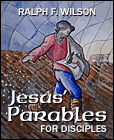 |
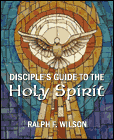
|
In-depth Bible study books
You can purchase one of Dr. Wilson's complete Bible studies in PDF, Kindle, or paperback format -- currently 48 books in the JesusWalk Bible Study Series.
Old Testament
- Abraham, Faith of
- Jacob, Life of
- Moses the Reluctant Leader
- Joshua
- Gideon
- David, Life of
- Elijah
- Psalms
- Solomon
- Songs of Ascent (Psalms 120-134)
- Isaiah
- 28 Advent Scriptures (Messianic)
- Daniel
- Rebuild & Renew: Post-Exilic Books
Gospels
- Christmas Incarnation (Mt, Lk)
- Sermon on the Mount (Mt 5-7)
- Luke's Gospel
- John's Gospel
- Seven Last Words of Christ
- Parables
- Jesus and the Kingdom of God
- Resurrection and Easter Faith
- Apostle Peter
Acts
Pauline Epistles
- Romans 5-8 (Christ-Powered Life)
- 1 Corinthians
- 2 Corinthians
- Galatians
- Ephesians
- Philippians
- Colossians, Philemon
- 1 & 2 Thessalonians
- 1 &2 Timothy, Titus
General Epistles
Revelation
Topical

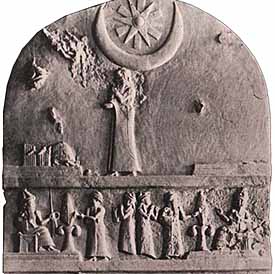
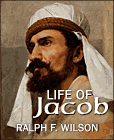
 To be notified about future articles, stories, and Bible studies, why don't you subscribe to our free newsletter, The Joyful Heart, by placing your e-mail address in the box below. We respect your
To be notified about future articles, stories, and Bible studies, why don't you subscribe to our free newsletter, The Joyful Heart, by placing your e-mail address in the box below. We respect your